Wilson marine cellular, the testing begins
I probably made the PR guy’s day! He called out of the blue with two questions — did I think that many boaters care about cellular boosters and had I heard of Wilson Electronics? — and my reply was not only “heck, yes” on both counts but also a report on how pleased I already was with the Wilson amp I installed on Gizmo last September. The company may have just decided to pay attention to the boat world, but I was more than ready to test the box of Wilson gear that recently showed up at Panbo HQ…
First I’ll touch on some things I’ve learned about cell booster technology over the years, because it’s trickier than you might presume. Check out this this 2004 PMY article; just the subtitle — “Lying handsets, wireless wireless, and other marine cellular shenanigans” — suggests the trickiness I encountered in testing. It was hard, for instance, to tell how well a booster worked because the typical four or five bar indicator at the top of a phone screen is generally inaccurate and/or slow to respond to changing conditions. Plus the cell service providers didn’t want to even acknowledge boosters anyway.
The situation got worse after I wrote that piece. Fewer and fewer cell phones came with an external antenna port that could be wired to a booster (which was an annoyance) and the solution of repeating the cell signal inside your boat, and re-transmitting your outgoing signals from your mast, turned out to be problematical. Several owners and installers told me that their $500+ repeater systems didn’t seem to do anything — probably because of “oscillation” issues, I was learning — and stories went around about how boosters could mess up cell towers and bring down the wrath of the FCC, AT&T, Verizon. etc. Yikes!
In fact, at one point the FCC considered banning all cell boosters, but when looking for information about this I found an impressive interview with the COO of Wilson Electronics. And when Pat Harmon detailed his successful boat booster install on Panbo in 2010, it was Wilson gear he used. Despite the complications, this company has built a solid reputation and its pricing seems very competitive…
If you poke around the Wilson Electronics site, you’ll see that they offer a large variety of booster bits, but photographed above is a fairly typical marine system they sent for testing. At top is the Marine Antenna (I didn’t know they offered) which retails for about $170 but seems available for $100. The blue booster is a SOHO 60 ($250 street
), which has some neat features I’ll get into further along, and then there’s that rectangular Low Profile inside antenna at about Amazon $16
and the 12v-to-6v adapter you may need as the SOHO comes with an AC version…
The build quality of everything looks good to me, with the possible exception of the 21-inch marine antenna. What worries me are those “chrome-plated” bars you screw in to create the unusual “radial ground plane.” On the other hand, Wilson does supply that little tube of goo to secure their threads as well as that optional stainless coupler that lets you exit the cable above the base. And many installers will like the pigtail as it makes it easy to upgrade to low loss LMR400 type cable (which Wilson also sells) instead of the RG58 shown. This antenna will also handle a very wide assortment of cellular frequencies, another complication I’ll get to…
What’s installed on Gizmo now, and really helped me stay in touch while travelling south, is a 30-inch Digital Antenna 561 cell stick cabled to a Wilson 801201 amp and then to their cradle antenna. So I don’t have to worry about a feedback loop but then again my phone only gets boosted when in the cradle. I don’t mind that much — especially as I am usually using my “old guy Bluetooth headset” — but my guests and crew would probably appreciate an inside antenna with more range. So I’m excited about trying not just that Low Profile antenna but also the more serious directional Panel Antenna seen above…
That’s where the special features of the AG SOHO 60 come in. You can not only adjust the amount of gain used for the two major cell bands to avoid oscillation between the inside and outside antennas — also useful for saving power when you’re only using one band — but on startup the unit tests for problems, uses its LEDs to show what’s going on, and will even shut down a band if needed. In fact, that’s why the 800 MHz LED seen in the top photo is red! Though I set up the Marine Antenna on a 10-foot pole outside the lab and pointed the panel away from it, apparently the signals got mixed up until I moved the panel further further into the basement or turned the gain down more. Cellular repeating is tricky, especially when the outside antenna covers 360 degrees of horizon as a boat antenna must…
But once set up properly I did see what seemed to be improved cellular performance from the Wilson-boosted signal in my basement lab. I think I’ve also found a software tool that properly measures it. The left RadioMon screen on my Android phone above shows the signal without boosting while the middle screen shows the improvement. It’s not a radical improvement but not trivial either and every bit helps for voice and data, I think. And note that the phone’s signal status stayed at two bars the whole time! (I threw the third screen in to indicate just how important good cell coverage can be when cruising; without good WiFi in many places, my phone data usage got somewhat extreme.)
The RadioMon app can also log signal strength and deliver the logs via email. Thus I was able to graph a 25-minute session during which the phone never moved but the SOHO 60 was turned on and then off again. Pretty persuasive, don’t you think? Of course the real test will be when I get this gear installed on Gizmo and start gunkholing my way north. It seems that Wilson has improved the chances of successful cell repeating on a boat, or at least I don’t see the same self testing and gain control on the highly regarded Digital Antenna Powermax marine repeaters.
But, darn it, there are new complications to cell boosting in the age of 4G data. LTE uses frequencies outside the regular cell bands, which were already confusing enough as indicated in the table below. The Wilson antennas cover those new frequencies but the SOHO 60 doesn’t yet, though it didn’t show in my testing. However, the company already has some 4G cradle-style boosters and will soon have a SOHO-style model that will be switchable between the different 4G providers. Cell boosting is complex!


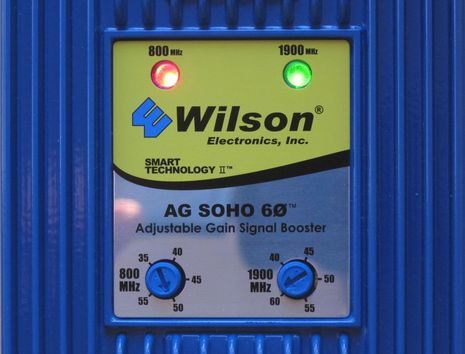
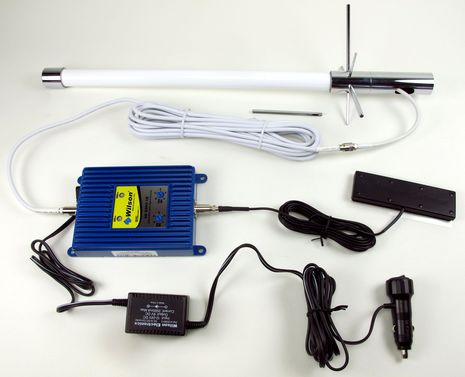
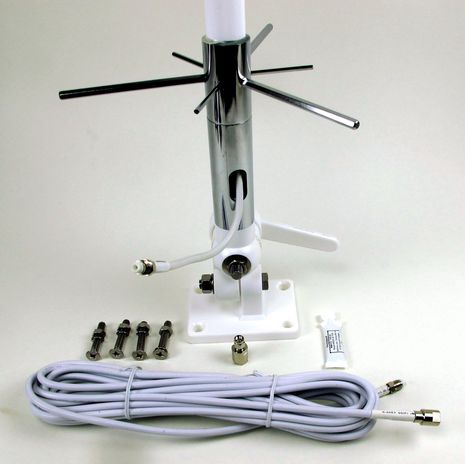
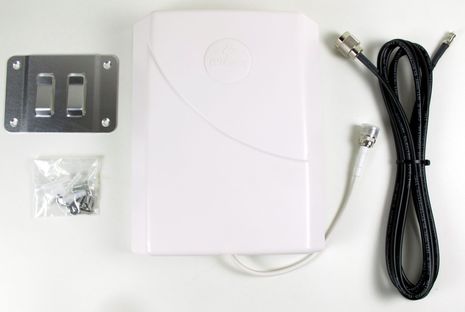
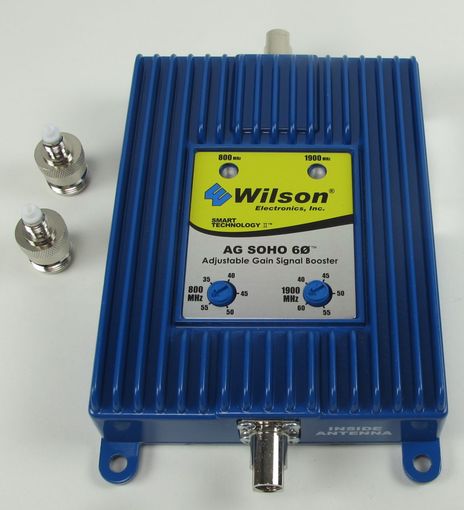
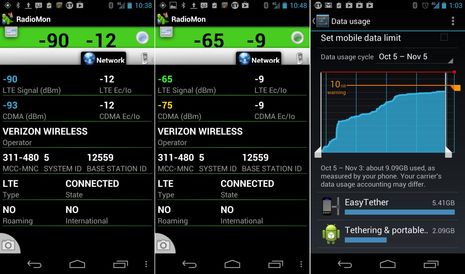
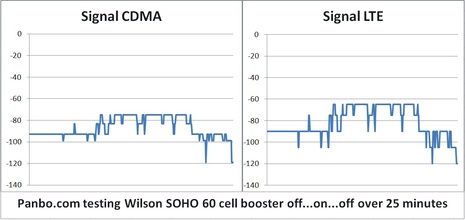

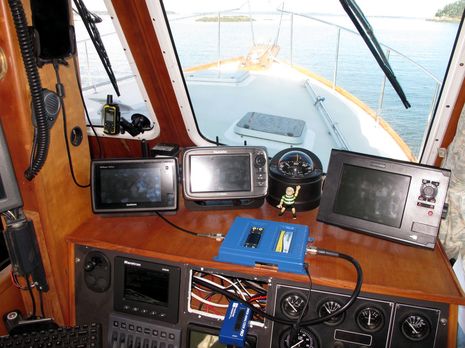









It would be really nice for boaters if they also did WiFi from the same unit. The frequencies are right there…
When I replaced my old cell phone with an android smartphone, my onboard Digital Antenna DA 4000 amp and antenna became obsolete (I thought)because the new phone had no external antenna port. However I came up with a really cheap solution.
Wilson cradle to DA 4000 amp to DA antenna. A male mini UHF to male FME adapter was added to my existing female mini UHF aft cabin bulkhead connector. The cradle was “free”. I borrow it from my desktop Wilson booster when I go cruising.
Works well. I know I am getting a boost since the phone alone is often otherwise unusable below deck.
Thanks, Joe, but you reminded me of another complication with these boosters, which is all the darn connector types in use. I think I like the FME style Wilson has mostly settled on — the female looking particularly easy to fish through tight places — but notice that they used an N Type connector on the panel antenna. I know the N is better for larger diameter coax cable like LM400 and thus, I guess, the two FME-female-to-N-Female adapters they put in the test box (seen in the SOHO 60 amp photo above).
Unfortunately the nice coax connector site I found years ago — http://tinyurl.com/panbo-connectors — doesn’t seem to include FME. Anyone know a better place to figure out how to connect miscellaneous cellular doodads together?
Peter, I agree that a combo cell booster and high power WiFi radio would be nice for a boat but I fear it doesn’t fit well in the other (and larger) markets Wilson works in.
A good boating feature to consider, is a switch that would frustrate inbound calls and text messages. Only outbound calls would be boosted. Ideally it would trigger automatically if the boat is underway, so we can concentrate on sailing the boat safe without calls that interrupt.
I am not suggesting blanket jamming, just a feature that gives boaters that ability to say I must have been out of range, while giving them the freedom to make calls if they desire or an emergency.
Gosh, Dan, I hope you’re kidding?
I have been using a dual band Wilson amp (no adjustable gain–which is a good feature) for almost 3 years–three antennas–one car, one boat and one RV. I use the small plate antenna in close proximity to my cell phone or MiFi hot spot. I often can get signals where no-one else can. Not much of a problem with feed back, but you have to watch for it.
You still need good line of site, but it definitely extends the range.
Definitely worth having aboard! Thanks for testing.
Yes, I am kidding. While there are times I don’t want to promote / enable telephone conversations on the boat, staying connected is an addiction many people have of recent, and I find my self enabling them so their addiction doesn’t become an impediment to enjoying boating.
For example I bring my MyFi/hotspot device onto the boat so my racing crew can use their laptops to finish up work while we are motoring out to the race course.
I can see a need for the Wilson product. MiFi doesn’t work outside of cell range nor does it help folks aboard that have a cellphone.
You could just turn off your phone. No cost/ no complication solution.
I have had a Digital Antenna repeater (not sure of model, it’s on the boat) for the six years I have been at a marina with severe cell reception problems.
The repeater never seemed to do anything, but I finally found a directional antenna and initial tests seem promising.
Another boat in the marina has done well with a directional antenna and some people sit on his deck when they need to make calls.
I find that I usually connect to a cell tower on the other side of the Chesapeake Bay rather than two towers that are closer (you can see that in mapping apps before GPS kicks in). Pointing the directional antenna at a closer tower seems to help with signal strength.
I also note that the NOAA weather and tide station in my marina has a similar directional antenna pointing to a nearby cell tower.
Jon
Ben, the difference between 90db and 65db (in your screenshot) is massive. 65dbm is about .0000000003 watts, 90dbm is about .000000000001 watts – a 300% difference.
I have just purchased a SOHO 65 for our home out in the boonies and will let you know how it goes. Of course I get to use directional antennas, so I am looking forward to an easy set-up.
Thanks, Eric! Did you notice Wilson’s “coming soon” AG Pro Quint? Highly adjustable, with a small LCD to see what you’re doing, and supports 700MHz 4G. http://goo.gl/ejkQC Probably overkill for you, but sign of things to come. By the way, I wouldn’t have predicted 4G for midcoast Maine any time soon, but we got it from Verizon a few weeks ago.
At Ben’s invitation I did write up my experience with cell phone amplifiers in 2010. It is now three years later and I am still using the same equipment with excellent results. I am not aware of any interference issues. I still attract people using their cell phones on the dock next to my wherever I am moored.
The single most important benefit is getting Internet access with my iPhone out on the water. The multitude of marine weather information om the WEB far exceeds what NOAA weather radio provides. I consider a cell phone amplifiers near essential equipment on my boat.
Related issues to cell phone amplifiers is:
1) Affordable cell phone access in Canada for Me.
2) I am still waiting for a long range form of WiFi.
Patrick Harman
Oak Harbor, WA
I’m using a Zboost which is not designed for marine use but works for me.
Right now the antenna is just hoisted up my mast but works great and is just a small one with no ground plane.
The base unit repeats the cell signal to about 30 -40 feet,so it works all over the boat.
My marina is tucked into a bay on the north side of a hill on the other side of where the tower is.
With out the Zboost I usually have no signal.
Yeah I have seen people wander down to my end of the dock to get a signal..they don’t know they are going thru my booster.
Zboost is $400 for the basic model I have; I don’t know if that is comparable.
Um, WiFi is at 2400 Mhz, or 2.4 Ghz. Cellular 2G, 3G, 4G is at 700 to 1900 Mhz with some 2600 Mhz in Europe. Not very close to what MOST repeaters or amplifiers can do. And then there’s the antenna being able to work on 2400 Mhz band as well.
It’s called a power button on a hand phone or smart phone … or put it on vibrate and ignore incoming calls. On your PBX if your boat has one turn down the wheelhouse extensions volume. Other crew members on bigger boats can answer calls and take a message – telling them you are driving the boat.
WiFi uses TDD signaling timed signals on the same frequency, where most cellular providers use FDD or sperate UL and DL frequencies the same amplifier is not compatable even if the signals were in the same bands which they are not.
I’m a so-so fan of the direct connect amplifiers or the newer cradle amplified units but believe that open loop boosting of cellular signals on small fiberglass boats can cause more harm then good.
Amplifying a poor quality signal from one carriers signal while having a strong signal from the other cell carrier will cause these amplifiers to shut down or provide little usable gain for your device. Not many low end BDAs have the filtering needed to block other carriers unwanted signals.
At best it’s a crap shoot.
This can be a real problem in the US PCS cellular bands.
Now using an outside Omni and low loss cable direct connected to a data modem or MiFi will usually result in stable good results without any chance of oscillation. Just convert or forward your cell number to a VOIP line for the best overall performance when your on the boat.
Bill Lentz
Wireless One
Bill, I just put up a testing entry about the Wilson AG Pro Quint booster and I believe that it can manage multiple bands causing feedback loops on even my 37-foot fiberglass vessel (also without overpowering cell sites). But it’s not inexpensive and it does have to be adjusted when the boat changes location.
https://panbo.com/archives/2013/10/testing_the_wilson_ag_pro_quint_and_hello_shakespeare_anywhere_cell_boosters.html